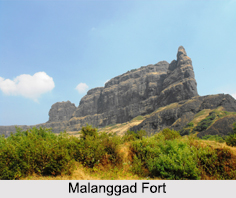 Malanggad Fort is a hill fort located in the Matheran Hill Range, Raigad district of Maharashtra. It is known popularly as "Haji Malang", which is one of the most famous among the three Sufi shrines located on the hill. Malanggad Fort is different from other forts in Maharashtra. This is the only fort which does not have a watch tower in and outside of the fort surroundings.
Malanggad Fort is a hill fort located in the Matheran Hill Range, Raigad district of Maharashtra. It is known popularly as "Haji Malang", which is one of the most famous among the three Sufi shrines located on the hill. Malanggad Fort is different from other forts in Maharashtra. This is the only fort which does not have a watch tower in and outside of the fort surroundings.
History of Malanggad Fort
Malanggad was built by the King Naladev of Maurya Dynasty in 7th century. The fort was home to a Nathpanthi Saint named “Machhindranath†during this period. Ketakars were the Quiladar"s of the fort. The fort was initially captured by the Marathas in the 17th century and was later conquered over by the British. Colonel Hartley, Captain Jameson and their troops advanced on Malanggad Fort and finally defeated the Marathas.
Mythology of Malanggad Fort
The violence on the common folk and the havoc created in the state by the demons has reached unbearable proportions. The cry from the oppressed had reached to God and God ordered Baba Malang to pay a visit to the place from where these crimes against the society are committed and to ensure safety and wellbeing of the common man by eliminating these demons.
Structure of Malanggad Fort
Malanggad Fort is well built at a height of 790 meters above the sea level. The structure of the Malanggad Fort is three-storeyed, and each tier has a specific name.
The lowest, "Pir Machi", is a plateau upon which the famous Dargah of Haji Malang is situated. It is named after the five Pirs who accompanied Haji Malang. The next higher level, "Sone Machi", is a rock-projection and is the lower part of the fort. It is shaped like an elephant trunk. It has a parapet wall with bastions on two sides. Upon the summit of the hill lies the citadel. The hill top has limited fortifications and not much remains of the fort are extant as well. There are some water cisterns which are a reservoir of fresh water.
Celebration at Malanggad Fort
During Urs festivals, the Palki of Baba is taken on round around the whole mountain and celebrated with pomp. The mountain is lit with lights and becomes a sight worth watching. There are many temples and mosques on the way to Malanggad Fort.
Visiting Information of Malanggad Fort
Mangalwadi Village is the base to reach the Malanggad Fort. From the base, one has to walk and climb many rock stones. There are also fine stone carved steps and stone blocks step built here to reach the top of this hill.



















